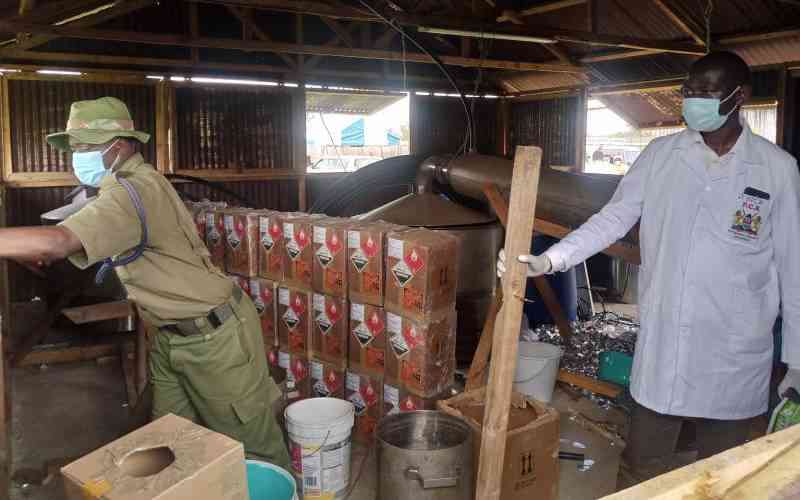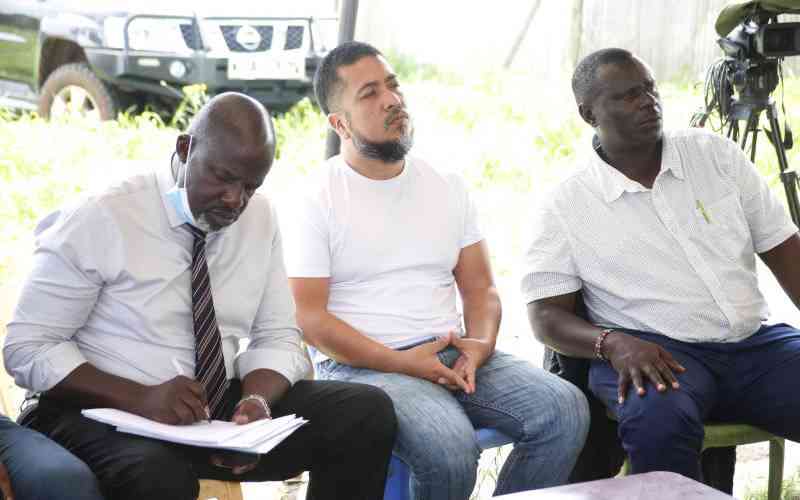Scenario 1: Your baby has a slight fever and a runny nose, you run to the chemist, buy an antibiotic and give it to the child for a few days.
Scenario 2: You experience that general ill feeling associated with flu or cold, you don’t want to deal with the pesky symptoms and you reach for an antibiotic from your medicine cabinet.
Scenario 3: You go to the doctor for one problem or the other, they prescribe some antibiotics, you adhere to the instructions for the first four days, then because you now feel better, you don’t bother to complete the dose.
Scenario 4: You are a proud farmer, and you keep animals that you routinely give antibiotics. You also sell the animals to slaughterhouses.
*Scenario 5: Every time you go to a health centre, you are prescribed for antibiotics, even for simple conditions that could go away on their own.
If you can relate to these scenarios, Dr Sam Kariuki, the director of the centre for microbiology research at Kenya Medical Research Institute, says you have got another think coming.
This is because, you are setting your children, yourself and the world up for a dangerous consequence referred to as antibiotic resistance. This means that you will go to the hospital seeking treatment for a condition, and the drugs that could have otherwise helped your condition won’t work anymore. Moreover, if you transmit the drug-resistant bug to another person, they will suffer more for it.
“Flus and colds are caused by viruses. And antibiotics treat bacterial infections. This means, the cold and flus don’t respond to antibiotics. If you use antibiotics to treat viral diseases, you are exposing the normal microflora (the bacteria and other microbes naturally present in the body) to levels of antimicrobials over time and that will cause some mutations. Mutations that might lead to development of antibiotic resistance,” explains Dr Kariuki.
Granted, scenario five is not of your own doing, but ultimately, overuse of antibiotics, even prescribed ones for simple infections one can naturally recover from, can lead to resistance.
“Overuse of antibiotics cannot be divorced from lack of proper diagnosis. Some medics will use empirical treatment (based on observation) for certain infections because they are unable to pinpoint the exact disease. You find someone getting a prescription of antibiotics because they (medics) have checked for symptoms only and concluded that the patient needs antibiotics,” he adds.
Just last year in November, the Kenyan government warned that misuse and overuse of antibiotics was making common infections increasingly harder to treat. In other words, the disease-causing microorganisms are getting tougher and harder to beat with the available drugs, leading to worse clinical outcomes and death. This is in addition to consuming more health care resources than patients infected with non-resistant strains of the same bacteria.
Already, researchers and medics are grappling with the problem. And it is worse in the towns.
“It is a big problem. Sometimes one microorganism can be resistant to up to eight antibiotics. In urban settlements, resistance to commonly used drugs, like Ampicillin and Chloramphenicol, is at a high of 60 to 75 per cent. In places prone to for instance tuberculosis, there is a big problem of antibiotic resistance,” Dr Kariuki explains.
And no one knows this better than Stephen Kinuthia, a resident of Nakuru. When he was diagnosed with multidrug resistant tuberculosis (MDR-TB) in February 2018, he had no idea how arduous the journey would be. There are two types of TB; Pulmonary tuberculosis (TB) and multidrug-resistant TB.
Pulmonary TB is caused by the spread of TB bacteria (Mycobacterium tuberculosis) from an infected person to another. This is easier to treat with medication, and complete therapy would take around six months. On the other hand, the multidrug-resistant (MDR-TB) type needs a more intense therapy for about nine months.
Stay informed. Subscribe to our newsletter
“Taking at least 18 tablets at a go, and injections every day was not easy,” explains Kinuthia. And the side effects were unpleasant too. I had joint pains, sleeplessness, irritation by sounds and horrible dreams.”
Drug-resistant TB develops when:
· One does not take their TB drugs regularly
· Does not take all the medication
· Develops TB a second time
· Is from a location where the drug-resistant TB is common
· Has spent time with someone who has the drug-resistant TB disease
“Sadly, the person who suffers most is the one who contracts it from another person who has the resistant type. This is why adhering to treatment is meant to also protect others within the surrounding,” says Dr Joseph Mburu, medical superintendent of Rift Valley Provincial General Hospital.
Fortunately, after nine months of treatment, Kinuthia was declared TB free.
Dr Mburu says that patients with tuberculosis are the most affected by antibiotic resistance.
“Antibiotic resistance is most common in treatment of TB, which has forced medics to move from one combination to another to be able to take care of TB bacteria because patients do not adhere to the full regime.”
Case of the super gonorrhoea
Besides TB, other diseases like pneumonia and gonorrhoea have also been impacted by antibiotic resistance too. Of great concern is the rise of the super bug gonorrhoea. Caused by a bacterium known as Neisseria gonorrhoea, the disease has notoriously developed resistance to outsmart the class of antibiotics used to treat it. WHO is concerned about a near future with a super bug that causes untreatable gonorrhoea. The bug infects the cervix, uterus and oviducts (fallopian tubes) in women, and urethra in both men and women. It can also cause infection in the eyes, mouth, throat and rectum.
In Kisumu, studies carried out between 2000 and 2010, showed a 50 per cent increase in resistance of gonorrhoea to ciprofloxacin, a drug that was previously used to treat it. Even though adherence to medication will treat the infection, it will not restore any permanent damage caused by the infection.
Resistance to treatment is not just limited to diseases caused by bacteria. Drug resistance has been noted in diseases like malaria, HIV and Influenza. The growing prevalence of resistance is also putting the achievements of modern medicine at risk. Organ transplantations, chemotherapy and surgeries such as caesarean sections become much more dangerous without effective antibiotics for the prevention and treatment of infections.
The Covid-19 connection
Antibiotic resistance is expected to get worse as the world battles with the pandemic.
“While it is difficult to know at a glance to what extent Covid-19 will contribute to antibiotics resistance, the effects will come gradually and will be seen at the end of the pandemic,” says Dr Kariuki, the director of the centre for microbiology research at Kemri.
But what do they know for sure?
“We know that Covid-19 being a viral infection also comes with a lot of secondary infections that also require antibiotic treatment and given the fact that antibiotic resistance comes from use and overuse of antibiotics. So if in whatever setting, if the treatment of Covid-19 does involve use of antibiotics at certain levels to probably treat secondary infections, then to that extent, it would encourage resistance,” Dr Kariuki explains.
Can it be reversed?
It is possible to reverse resistance to an antibiotic. This may work if the drug is withdrawn for some time to help the bacteria sort of mutate into one that is not resistant to the said drug.
“Simply explained, if you withdraw the antibiotics, over some time, the bacteria does not ‘sense’ pressure from that antibiotic and then it sort of ‘forgets’ about the antibiotics and loses that genetic element that causes resistance because it no longer needs it,” says Dr Kariuki.
Once that is lost it means that the organism now becomes sensitive to the antibiotic when reintroduced.
“In the 1980s and early 90s in South East Asia where typhoid fever is endemic, there was a lot of drug resistance to first line treatments. At that time they used one of three antibiotics; Ampicillin, Cotrimoxazole and sometimes Chloramphenicol for adults. In the 90s however, the microorganisms developed resistance to them. And so they started using different antibiotics like fluoroquinolone and avoided the three for some time,” Dr Kariuki explains.
This makes one wonder how bad the resistance to one type of antibiotic can be if there is an alternative antibiotic that works. Well, it isn’t that simple.
An analysis by WHO also states that when infections can no longer be treated by first-line antibiotics, more expensive medicines must be used. A longer duration of illness and treatment, often in hospitals, increases health care costs as well as the economic burden on families and societies.
Over time countries like Nepal are now reporting that there are certain strains of the fever that are now responding to the first line drugs that had ceased to work.
It will take more than just personal responsibility
Can anything be done to ensure only qualified people can dispense antibiotics?
In Kenya, according to Dr Kariuki, the official channels of importation of antibiotics that can be monitored account for only a proportion of antibiotics that are commonly available for human and livestock.
“You find that maybe official channels account for only 60 per cent of what is in the market but what of the 40 per cent? It means somebody is importing in the market that is not accounted for in terms of usage in the country.” he adds.
Sometimes some of these antibiotics end up in the very remote areas because they are being promoted by sales people who want to make a profit. This works because sometimes families do not want to travel for long distances to seek professional opinion because it is expensive and also time-consuming.
So they will just walk into a chemist or a health centre and order the antibiotics from there.
 The Standard Group Plc is a
multi-media organization with investments in media platforms spanning newspaper
print operations, television, radio broadcasting, digital and online services. The
Standard Group is recognized as a leading multi-media house in Kenya with a key
influence in matters of national and international interest.
The Standard Group Plc is a
multi-media organization with investments in media platforms spanning newspaper
print operations, television, radio broadcasting, digital and online services. The
Standard Group is recognized as a leading multi-media house in Kenya with a key
influence in matters of national and international interest.
 The Standard Group Plc is a
multi-media organization with investments in media platforms spanning newspaper
print operations, television, radio broadcasting, digital and online services. The
Standard Group is recognized as a leading multi-media house in Kenya with a key
influence in matters of national and international interest.
The Standard Group Plc is a
multi-media organization with investments in media platforms spanning newspaper
print operations, television, radio broadcasting, digital and online services. The
Standard Group is recognized as a leading multi-media house in Kenya with a key
influence in matters of national and international interest.









